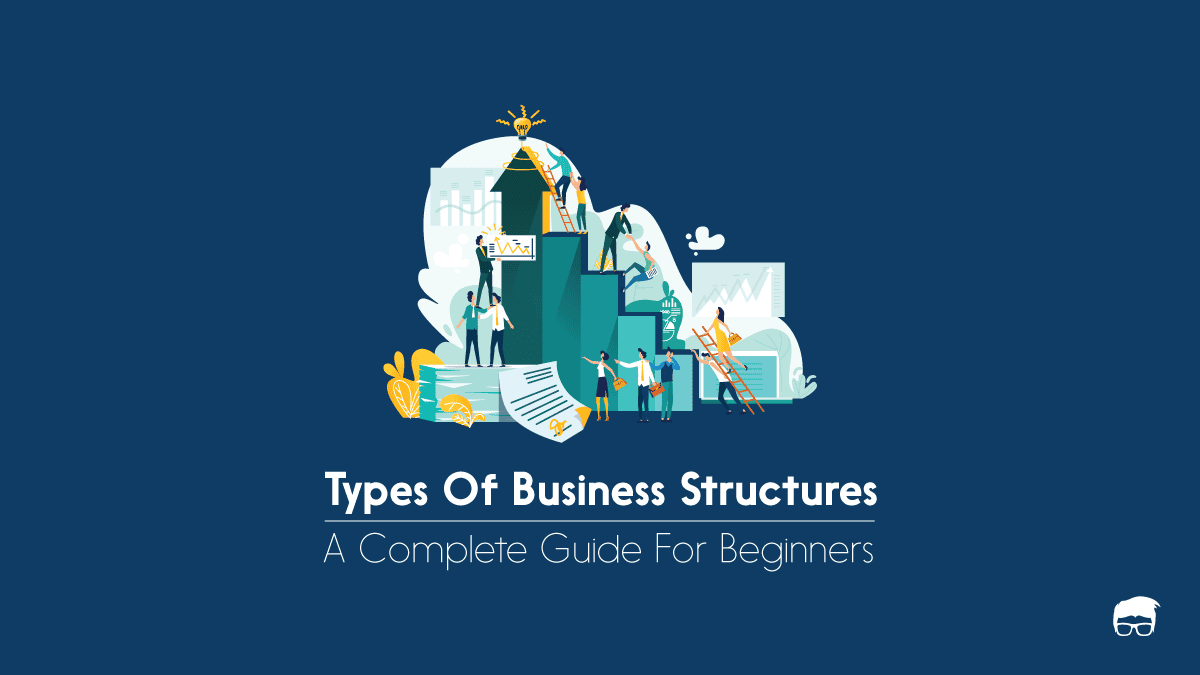Not all businesses are the same. Some have big teams and need a lot of money to start, while others are run by just one or two people with minimal costs.
To address this, governments recognise different business structures. Each one comes with its own legal and financial rules, along with its pros and cons.
These business structures are the reason one sees LLP, LLC, Inc., and other tags with business names. Understanding these types of business structures is important for entrepreneurs, as it helps them make informed decisions about their business.
What Is A Business Structure?
A business structure is a legal setup that decides how a company is owned, run, and taxed. It affects things like:
- Who owns the business
- How decisions are made
- How taxes are paid
- What kind of personal risk the owners face
- How easy it is to change things as the business grows
Choosing the right structure for a business is critical. It can impact its success and growth down the road.
Types of Business Structures
Generally, there are five types of business structures that world governments recognise. Each has its own set of rules. These are –
- Sole proprietor: where a person runs the business and makes all decisions. It’s an easy way to get started, but it puts all personal assets at risk.
- Partnership: like sole proprietorships, but with two or more owners. For some businesses, this might make sense – it spreads risk and makes getting started easier.
- Limited liability company (LLC): a mix of sole proprietorship and corporation. Owners have protection from personal risk, but they also have to decide how profits are divided.
- Corporation: an independent entity that is owned by shareholders. They have limited liability and can raise money by selling shares.
- Cooperative: like a corporation, but the owners are also the customers of the business. Profits are shared among members based on their contribution to the cooperative.
Sole Proprietorship
Sole proprietorship refers to a business structure where one person owns and operates the company. In most countries, a business owner is automatically a sole proprietor unless they register for a different structure.
This business structure does not have any legal distinction from the owner. This means that all profits, losses, and liabilities belong to the owner personally. The business is not taxed separately, and the owner includes all business income on their personal tax return.
Sole proprietorship is suitable for businesses with only one owner who wants full control over decision-making. It has low startup costs and can be easily set up without much paperwork. However, it also means that the owner bears all financial risks and personal liability for any debts or legal issues.
Key Features of Sole Proprietorship
Here are some of the distinctive features of a sole proprietorship:
- Easy to start and dissolve: It does not require any legal or formal registration, making it an easy option for entrepreneurs.
- Unlimited liability: The owner is personally responsible for all debts and liabilities of the business.
- Single ownership: There can only be one owner in this structure.
- Taxation: The business is not taxed separately, and all profits are considered the personal income of the owner.
- Business decision-making: The owner has complete control over all business decisions.
Advantages Of Sole Proprietorship
Sole proprietorship comes with its own set of advantages, which makes it a popular choice for small business owners. Some of the benefits of this structure are:
- Easy to set up and operate: Sole proprietorship has minimal paperwork and legal formalities, making it easy to start and run. In fact, in most countries, a business is automatically considered a sole proprietorship unless registered otherwise.
- Full control: The owner has complete decision-making power and control over the business’s operations.
- Tax benefits: As the business is not taxed separately, the owner can include all profits and losses in their personal tax return, potentially reducing their overall tax liability.
- Low costs: Compared to other structures, sole proprietorship has low startup costs and does not require any registration fees or ongoing compliance expenses.
Disadvantages Of Sole Proprietorship
As with any business structure, there are also some drawbacks to sole proprietorship. These include:
- Unlimited personal liability: The owner is personally responsible for all debts and legal issues of the business. If the company fails, the owner’s personal assets are at risk.
- Limited growth potential: Sole proprietors may have limited access to capital compared to other structures like corporations or LLCs, which can hinder business growth opportunities.
- Reliance on one person: With only one owner, this structure is entirely dependent on that person’s skills, expertise, and availability. This could be a disadvantage if the owner has limited resources or knowledge in certain areas.
Partnership
A partnership is a business structure where two or more people own and run a business together. They split profits, losses, and decision-making based on their agreement.
Partnerships can be formed through a written or verbal agreement. It is essential to have a legal partnership agreement in place to avoid any misunderstandings or conflicts down the road.
Types of Partnerships
There are two main types:
- General Partnership: All partners share equal responsibilities and liabilities.
- Limited Partnership: Limited partners only provide capital and are not involved in running the business. They also have limited liability, meaning they aren’t personally on the hook for business debts.
Here’s an example explaining general and limited partners:
Two friends, Alice and Bob, started a business together. Each puts in $50,000. Alice handles day-to-day operations, while Bob is only providing money.
- If they form a general partnership, they both have equal say and equal liability.
- If they go with a limited partnership, Alice would be the general partner, running the show and assuming full liability. Bob would be the limited partner, protected from personal liability but with no role in decision-making.
Key Features of a Partnership
Here are some of the distinctive features of a partnership:
- Shared decision-making: All partners have an equal say in business decisions unless otherwise specified in the partnership agreement.
- Shared profits and losses: Profits and losses are divided according to each partner’s percentage of ownership or as outlined in the partnership agreement.
- Limited liability for some partners: In a limited partnership, not all partners face personal risk. General partners handle business debts, while limited partners only contribute capital.
- Taxation: Partnerships don’t pay taxes as a business. Instead, each partner reports their share of profits or losses on their personal tax return. This is known as “pass-through taxation.”
Advantages of Partnership
Partnerships have several advantages that make it a popular business structure, including:
- Shared responsibility and workload: Partners can share the burden of running the business, allowing for more efficient decision-making and operations.
- Complementary skills: Each partner brings different skills and knowledge to the table, making partnerships beneficial for businesses with diverse needs.
- Tax benefits: Similar to sole proprietorship, partnerships can enjoy pass-through taxation where profits are taxed at individual rates rather than corporate tax rates.
Disadvantages of Partnership
Partnerships also have some drawbacks, such as:
- Personal liability: In general partnerships, all partners assume unlimited personal liability for business debts and legal issues.
- Potential conflicts: Disagreements and conflicts can arise between partners, especially when it comes to decision-making or sharing profits. Having a detailed partnership agreement in place can help prevent such conflicts.
- Limited growth potential: Similar to sole proprietorship, partnerships may have limited access to capital compared to other structures like corporations or LLCs. This could hinder the business’s growth opportunities.
Corporation
A corporation is a legal structure that separates the business’s assets and income from its owners. This means that the corporation can sue or be sued, enter into contracts, and conduct business in its own name.
Types of Corporations
There are two main types:
- S Corporation: This type of corporation provides limited liability to its shareholders while allowing profits and losses to pass through to their personal tax returns, similar to partnerships. However, it has strict eligibility requirements, such as a limit on the number of shareholders and only one class of stock.
- C Corporation: A C corp is subject to double taxation, meaning it pays corporate taxes on profits, and then shareholders also pay personal taxes on dividends received. However, it has no restrictions on the number of shareholders or classes of stock.
Key Features of a Corporation
Here are some key features of a corporation:
- Limited liability: Shareholders are not personally liable for the business’s debts and legal liabilities. Their risk is limited to their investment in the company.
- Perpetual existence: Corporations continue to exist even if a shareholder leaves or passes away. In simple terms, the company has a life of its own that is separate from its owners.
- Separate legal entity: A corporation is considered its own legal entity, separate from its owners. It can enter into contracts, sue or be sued, and conduct business in its own name. For example, if the corporation ends up not paying its debt, it is the corporation that is responsible rather than the shareholders, and the lenders can only sue the corporation for payment- not the individual shareholders.
- Centralised management: The board of directors oversees the overall management and decision-making for the corporation. Shareholders only have a say in major decisions through their voting power.
Advantages Of Corporation
Corporations have several advantages, including:
- Access to capital: The corporation can raise money by issuing stocks or bonds, allowing for more growth opportunities.
- Limited liability: Shareholders are not personally liable for business debts and legal issues.
- Perpetual existence: The corporation can continue to exist even if shareholders leave or pass away.
- Credibility: Corporations often have more credibility and a stronger brand reputation, making it easier to attract investors and customers. This is majorly because corporations’ identity is different from the identities of their shareholders.
- Ownership Transferability: Ownership in a corporation is easily transferable through the sale or transfer of stock to another party.
Disadvantages Of Corporation
The drawbacks of corporations include:
- Double taxation: C corps are subject to double taxation, meaning profits are taxed at the corporate level and again when distributed as dividends to shareholders. This can reduce profits for shareholders.
- Complex formation and maintenance: Corporations require extensive paperwork, legal fees, and ongoing compliance with state regulations. They also have more reporting requirements compared to other business structures.
- More expensive: The cost of forming a corporation is higher compared to partnerships or sole proprietorships. Additionally, they may also be subject to various taxes and fees imposed by their state of incorporation.
- Compliance requirements: Corporations have more compliance obligations, such as annual meetings, record-keeping, and filing taxes.
LLC (Limited Liability Company)
A Limited Liability Company (LLC) is a hybrid business structure that combines the benefits of both corporations and partnerships.
It offers limited liability protection to a corporation while allowing for pass-through taxation like a partnership.
To explain it better, an LLC provides –
- Limited liability protection to its members, meaning their personal assets are not at risk if the business faces debts or legal issues.
- At the same time, an LLC’s profits and losses can be passed through to its members’ individual tax returns, avoiding double taxation.
Key Features Of LLC
Some key features of an LLC include:
- Limited liability protection: Members (owners) are not personally liable for the business’s debts and legal liabilities.
- Pass-through taxation: LLCs enjoy pass-through taxation where profits and losses are reported on each member’s personal tax return. This avoids double taxation.
- Flexible management structure: Unlike corporations, LLCs do not have a strict hierarchical management structure. Instead, members can choose to manage themselves or appoint a manager to handle the business’s day-to-day operations.
- Less paperwork and formalities: LLCs have less stringent reporting requirements compared to corporations, making them easier and cheaper to maintain.
- Flexible profit distribution: LLCs can choose how they want to distribute profits among members, unlike partnerships where it must be done according to the predetermined percentage of ownership. This allows for more flexibility in decision-making and sharing of profits.
- Management Structure: LLCs can be managed by its members or appoint a manager to handle the day-to-day operations.
Advantages Of LLC
Some benefits of forming an LLC include:
- Limited liability protection: Members are not personally liable for business debts and legal liabilities. This means their personal assets are safe from business-related issues.
- Tax Flexibility: LLCs enjoy pass-through taxation, avoiding double taxation.
- Management Flexibility: LLCs have a more flexible management structure compared to corporations.
- Less paperwork and formalities: LLCs have less stringent reporting requirements, making them easier and cheaper to maintain.
- No ownership restrictions: LLCs have no restrictions on the number of members or classes of stock, allowing for more flexibility in ownership arrangements.
Disadvantages Of LLC
The drawbacks of forming an LLC include:
- Self-employment taxes: Members are subject to self-employment taxes on their share of profits. In contrast, shareholders in a corporation only pay personal income tax on dividends received.
- Limited growth potential: Unlike corporations, which can issue stocks or bonds to raise capital, LLCs may have limited options for securing financing.
- Varying state laws: LLCs are regulated at the state level, meaning the requirements and benefits may vary from state to state. This can make it challenging to expand the business into other states.
LLC vs Corporation vs Company
LLCs, corporations, and companies are all business structures commonly used by entrepreneurs. People also confuse company registration as synonymous with an LLC or corporation, but there are key differences between them.
- An LLC is a hybrid business structure that offers limited liability protection and pass-through taxation. It combines the flexibility of a partnership with the limited liability of a corporation.
- A corporation is a legal entity separate from its shareholders, offering limited liability protection and potential for growth through issuing stocks or bonds.
- A company refers to any type of business organisation formed for commercial purposes. This includes both LLCs and corporations but also encompasses other structures like sole proprietorships, partnerships, and cooperatives.
Aspect | LLC (Limited Liability Company) | Corporation | Company (General Term) |
|---|---|---|---|
Ownership | Owned by members (people or other companies) | Owned by shareholders | Can refer to any legal business type |
Liability | Members have limited liability | Shareholders have limited liability | Depends on the business structure |
Management | Flexible—managed by members or appointed managers | Managed by a board of directors | Varies based on structure |
Taxation | Pass-through: taxes on personal returns | Double taxation: company profits and dividends taxed | Depends on business type |
Compliance | Fewer rules and formalities | Stricter regulations and formalities | Varies by type and location |
Profit Distribution | Flexible—profits shared as members agree | Profits paid as dividends to shareholders | Depends on structure |
Best for | Small to medium businesses needing flexibility | Large businesses raising capital | Covers any business form; needs specifics |
Let’s say two friends, Sarah and Jake, want to start a business together.
- If they form an LLC: They both become members of the LLC. They have the flexibility to manage it themselves or hire a manager. Their personal assets are protected (limited liability), meaning if the business goes into debt, they won’t lose personal items like their house or car. Profits go directly to them and are taxed on their individual returns—no corporate tax involved. It’s simple, with fewer formal requirements.
- If they formed a Corporation, Sarah and Jake would become shareholders. They need a board of directors to manage the business, and they must follow stricter rules, like holding annual meetings. The corporation pays taxes on its profits, and then if Sarah and Jake get paid through dividends, they also pay taxes personally (double taxation). This structure is often used for larger businesses that want to raise capital through investors.
- If they use the term “Company” without specifying: “Company” is just a general term. It could refer to an LLC, Corporation, or other types of business. Without details, it doesn’t tell us anything about ownership, taxes, or management style.
Cooperative
A cooperative is a type of company that operates for the benefit of its members, who are also its customers or employees. It has an equal distribution of control among its members and may have different classes of membership based on their level of involvement and contribution to the business.
For example, a food cooperative may have members who are both customers and owners of the business. They have a say in how the business is run, but they also benefit from discounts or exclusive access to certain products.
Amul, the largest dairy cooperative in India, is a successful example of this business model. It has over 3 million members who are local milk producers and also own shares in the company. These members have a say in the management of the business, and they also receive dividends on their shares based on the profits earned by the company.
Cooperatives focus on meeting the needs and interests of their members rather than generating profits for external shareholders. This model often involves democratic decision-making processes, where each member has an equal vote in important decisions.
Some common types of cooperatives include:
- Consumer cooperatives: Owned by consumers who use the cooperative’s products or services. For example, REI, a popular outdoor gear retailer in the US, is a consumer cooperative owned by its members.
- Producer cooperatives: These are owned by producers who use the cooperative to market and sell their products. For example, Ocean Spray is a producer cooperative where cranberry farmers own shares in the company and receive profits based on the sales of their crops.
- Worker cooperatives: Owned and operated by the employees themselves. All employees have an equal say in decision-making and receive equal profits from the business. This model allows for more democratic control and profit-sharing among workers. Union Cab Co-op in Madison, Wisconsin, is an example of a worker cooperative.
- Housing cooperatives: These are owned by members who live in the housing units and have a say in how the cooperative is run. These cooperatives can provide affordable housing options for members and often involve a sense of community among residents.
- Agricultural cooperatives: Owned by farmers or agricultural producers who jointly sell their products or purchase materials at lower costs. These cooperatives can provide small farmers with more bargaining power in the market and help them reduce costs. Land O’Lakes, a farmer-owned cooperative in the US, is an example of this type.
Features of Cooperatives
Cooperatives are substantially different from other business structures in several ways:
- Voluntary Association: Cooperatives are formed voluntarily by members who come together for a common purpose or benefit. Membership is usually open to all, regardless of caste, religion, gender, or income.
- Democratic Control: Each member has an equal say in decision-making processes, regardless of their level of investment or involvement in the business. This promotes transparency and accountability within the organisation.
- Limited Interest on Capital: Unlike traditional businesses that aim to maximise profits, cooperatives limit the interest paid on capital investments to ensure that the focus remains on serving members’ needs rather than generating external profits.
- Patronage Refunds: Members may receive refunds based on their patronage (usage) of the cooperative’s products or services. This means that as members use and support the cooperative more, they receive a larger share of any profits earned. This incentivises member involvement and loyalty.
- Social Responsibility: Cooperatives prioritise social responsibility and community development, often reinvesting profits in the community or supporting charitable causes aligned with their values. This helps to build a positive reputation and creates a sense of purpose for members.
Advantages of Cooperatives
Cooperatives can offer several advantages compared to other business structures:-
- Easy Formation: Cooperatives can be formed with fewer formalities and legal requirements compared to corporations, making it accessible for smaller businesses.
- Equal Control: Each member has an equal say in decision-making processes, promoting a more democratic approach to management.
- Shared Risk and Profit: Members share the risks and profits of the business, creating a sense of ownership and responsibility among members.
- Reduced Costs: Cooperatives can often reduce costs for their members by pooling resources. This could include bulk purchases or shared marketing initiatives.
- Community Development: Cooperatives often reinvest profits back into the community, contributing to local economic development.
- Stability: Separate legal entity status and the potential for long-term membership can provide stability and continuity to a cooperative, making it less susceptible to external pressures.
Disadvantages of Cooperatives
While cooperatives have several advantages, they also face some unique challenges and disadvantages:
- Decision-making: In large cooperatives with a diverse membership base, decision-making processes can become slow and complicated due to differing interests and opinions.
- Limited Capital: Without outside investors or shareholder share capital, cooperatives may struggle to raise significant amounts of capital. This limits their ability to expand or take on larger projects.
- Conflict Management: As members are equal owners in the business, conflicts between members may be difficult to resolve and could potentially harm the cooperative’s operations. A clear conflict resolution process is crucial for effective management.
- Limited Flexibility: Unlike traditional businesses, cooperatives may be limited in their ability to adapt and change quickly due to democratic decision-making processes and strict adherence to cooperative principles.
Comparing Different Business Structures
Choosing a business structure is an important decision for any organisation. Each structure has its unique features, advantages, and disadvantages. Here is a comparison of all the common business structures:
Business Structure | Ownership | Liability | Taxes | Decision-Making | Profit Distribution |
Sole Proprietor | Owned by one person | The owner makes all decisions | Income taxed as personal income | Owner makes all decisions | All profits go to the owner |
Partnership | Owned by two or more partners | Shared personal liability | Pass-through taxation—profits taxed on personal returns | Decisions made jointly by partners | Profits split based on partnership agreement |
Limited Liability Company (LLC) | Owned by members (individuals or entities) | Limited liability—personal assets protected | Pass-through taxation, unless elected otherwise | Flexible—can be managed by members or managers | Flexible—profits distributed as agreed by members |
Corporation | Owned by shareholders | Limited liability—shareholders’ personal assets protected | Double taxation—corporation pays tax on profits, shareholders pay tax on dividends | Managed by a board of directors; shareholders vote on major decisions | Profits distributed as dividends to shareholders |
Cooperative | Owned by members (customers) | Limited liability for members | Pass-through taxation or taxed at cooperative level depending on structure | Democratic—members vote on key decisions | Profits shared based on members’ contributions |
A startup consultant, digital marketer, traveller, and philomath. Aashish has worked with over 20 startups and successfully helped them ideate, raise money, and succeed. When not working, he can be found hiking, camping, and stargazing.





![AI Legal Structure Selector [Unlimited & No Login] AI Legal Structure Selector](https://www.feedough.com/wp-content/uploads/2025/06/AI-Legal-Structure-Selector-150x150.webp)



